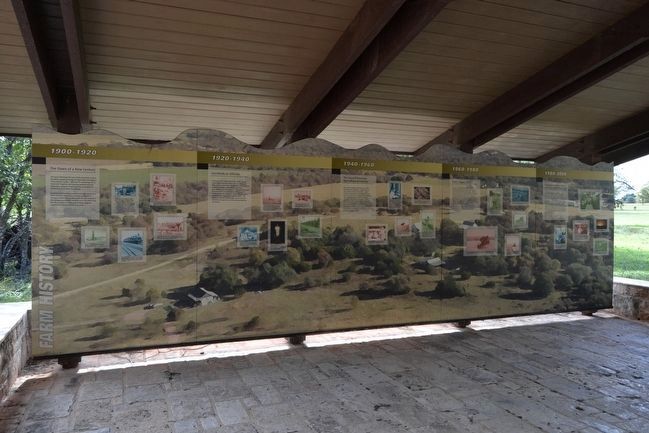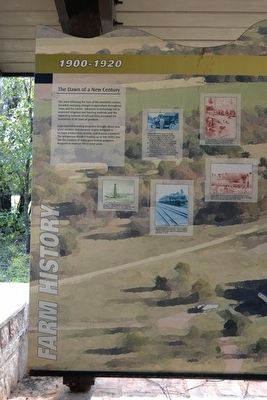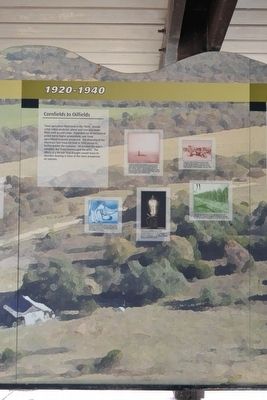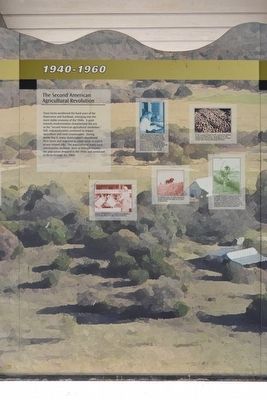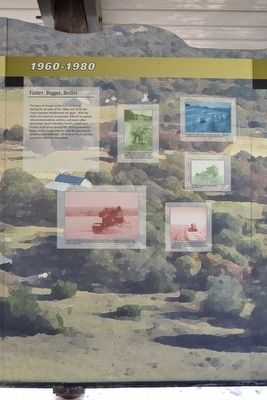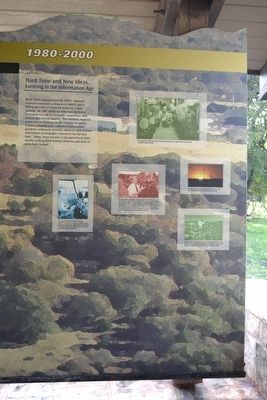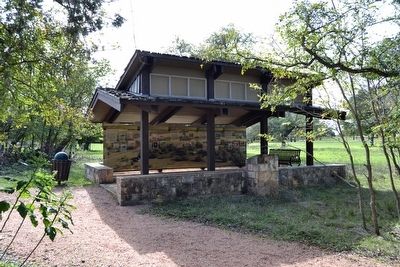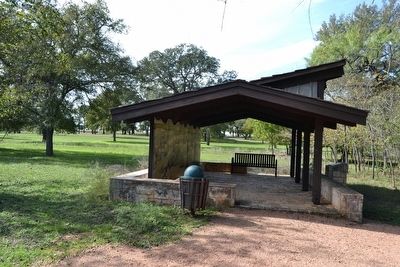Near Stonewall in Gillespie County, Texas — The American South (West South Central)
Farm History
1900 - 1920
The Dawn of a New Century
The years following the turn of the century heralded sweeping changes in agriculture throughout Texas and the nation. Advances in technology led to improved irrigation and farming methods and the expanding network of railroad lines increased the availability of all types of products.
Experimental breeding programs brought new plant varieties and livestock strains designed to increase productivity, quality, and disease-resistance. The prosperous decades leading up to the 1920's also saw the creation of many government programs designed to improve life in rural areas.
(Photo captions, from top left clockwise)
Between 1902-1916 a number of rural improvement programs developed, including:
--- The Reclamation Act of 1902 led to water projects for irrigation in western states. Texas was not included in the act until 1906.
--- In 1908, President Teddy Roosevelt created the Country Life Commission to address issues facing women and children on farms.
--- In 1914 the federal-state extension service began providing direct education for farmers.
--- The Federal Roads Act of 1916 created federal government subsidies for road building and improvement.
In 1903 development of a Hog Cholera serum stopped the spread of this devastating virus, eradicating it completely in the U.S. by 1978.
Jersey cattle, like those raised at the Sauer-Beckmann Living History Farm, remained the most popular dairy cattle on American farms until shortly after World War I (1917-1918).
By 1916 the network of railroads across the nation reaches it peak at 254,000 miles. Here in Gillespie County, the first trains rolled into Fredericksburg on November 17, 1913.
January 10, 1901 - A “gusher” discovered at Spindletop, near Beaumont, Texas, begins the shift from agricultural economy to an industrial one.
1920 - 1940
Cornfields to Oilfields
Texas agriculture flourished in the 1920s. Already a top cotton producer, wheat and corn also made their mark as cash crops. Expanded use of mechanical power led to higher productivity, and Texas’ agricultural economy prospered. The discovery of the enormous East Texas Oil field in 1930 served to bolster the economy. Oil became the state’s salvation, but Texas farmers paid the price. The effects of a decade long drought caused many to abandon farming in favor of the more prosperous oil industry.
(Photo captions, from top left clockwise)
Continued growth in the petroleum industry spared Texas’ economy the brunt of the Great Depression of the 1930s. However, Mother Nature was not so kind. The Dust Bowl, a series of droughts and severe weather lasted nearly a decade (1932-1940), and took its toll throughout the Southern Plains.
During the 1930s the first successful rubber wheeled tractors appeared. One of the most popular, the Allis Chalmers Model WC All-Crop sold more than 178,000 between 1933 and 1948.
1920 saw the organization of the first hybrid seed corn company. Use expands throughout the following decades, and by 1960 hybrid corn covers more than 96% of corn land.
The Rural Electrification Act of 1937 provided federal money for the expansion of electrical systems into rural areas. Newly elected Congressman Lyndon Baines Johnson vigorously supported the act.
The Surge Bucket Milker hits the market in 1923. Smaller and easier to disassemble and clean, the new design cuts down on bacteria counts in milk, and increases production.
1940 - 1960
The Second American Agricultural Revolution
Texas farms weathered the hard years of the Depression and Dustbowl, emerging into the more stable economy of the 1940s. A push towards modernization characterized this era as the “second American agricultural revolution.” Still, industrialization continued to impact agriculture and rural communities. During World War II, many sharecroppers abandoned their farms and migrated to urban areas in search of war related jobs. The population of many rural communities declined. Here in Gillespie County, the population dropped in the 1930s and continued to do through the 1960s.
(Photo captions, from top left clockwise)
In 1940 Stonewall felt the imapct of the Rural Electrification Act (REA), with the establishment of the Pedernales Electric Co-op. An amendment to the act in 1949 extended federal funding to telephone companies such as Southwestern States Telephone Company, which served Stonewall and surrounding communities. By 1954, nearly half of all American farms had telephones, and 93% had electricity.
In 1951, a group of 30 plus farmers organized the Gillespie County Fruit Growers Co-op. By the end of the 1950s Stonewall was one of the top fruit producing communities in Texas, with more than 2000 acres of fruit trees.
In response to heavy increases in the use of pesticides, Congress passed the Federal Insecticide, Fungicide, and Rodenticide Act of 1947. This act required the Department of Agriculture register all pesticides, and to refuse registration to and remove from the market, any products which were unsafe or ineffective.
By 1954 the number of tractors exceeds the number of horses and mules on U.S. farms for the first time.
Between 1941 and 1945 the popularity and availability of frozen foods changed the diets of many Americans.
1960 - 1980
Faster, Bigger, Better
The pace of change seems ever increasing. During the decades of the 1960s and 1970s the Texas economy transformed yet again. With the state’s oil resources increasingly difficult to exploit; telecommunications, airlines, and many other technology based industries found a home here. A surge in oil prices during the 1970s prompted a boom in the energy industry, and the agricultural economy soon followed. All three of Texas’ primary economic industries flourished.
(Photo captions, from top left clockwise)
In 1974 the Texas Department of Agriculture created the Family Land Heritage Program to recognize farms and ranches in continuous operation by the same family for 100 years +.
Throughout the 1960s railroads continued to deteriorate. Shipment of agricultural goods by truck, cargo plane and barge increased.
By 1968 mechanical harvesting of cotton increased to 96%.
No tillage agriculture, a soil conservation practice which involves reducing or eliminating plowing, became popular during the 1970s. Use of this practice continues to increase worldwide today.
Increased mechanization of farm equipment meant that fewer farmers were necessary to produce more crops. In 1930 one farmer supplied 9.8 people in the U.S. and abroad. By 1970 that number grew to 75.8, an increase of 673% in just 40 years.
1980 - 2000
Hard Time and New Ideas ... Farming in the Information Age
Bleak times characterized the 1980s. National economic recession, a drop in oil prices, and a failing agricultural economy made for a dark outlook. By 1987 prices for American farmland bottomed out due to increased competition with forging agricultural exports. The situation required a new way of thinking for the industry to survive. Farmers adopted more extensive conservation practices, embraced scientific advances, and utilized information technologies extensively for the first time. Today, Texas remains a top agricultural state, usually ranking third behind California and Iowa in gross farm income.
(Photo captions, from top clockwide)
Throughout the 1980s advances in bio-technology made it a viable option for improving crop and livestock strains.
In 1988 scientists warned that global warming could eventually affect the future of American farming.
Conservation programs such as the Food Security Act of 1985, Low Input Sustainable Agriculture (LISA), and the Conservation Reserve Program flourished during the 1980s and 1990s.
As competition intensified, farmers looked to diversity the types of crops they grew. Here in Gillespie County, the grape industry grew rapidly. Although Vineyards and wineries existed in the Texas Hill Country since the earliest European Settlement, most did not survive the prohibition era. Today the industry enjoys resurgence, with more than 30 wineries and 3500 acres of vineyards popping up during the last three decades.
On August 6 1991 the World Wide Web (WWW) debuted as a service available to the public on the internet. Many farmers recognize the value of this tool, utilizing it for everything from marketing to research.
Topics and series. This historical marker is listed in this topic list: Agriculture. In addition, it is included in the Former U.S. Presidents: #26 Theodore Roosevelt, the Former U.S. Presidents: #36 Lyndon B. Johnson, and the Rural Electrification 💡 series lists. A significant historical year for this entry is 1900.
Location. 30° 14.201′ N, 98° 37.487′ W. Marker is near Stonewall, Texas, in Gillespie County. Marker can be reached from Park Road 52, 0.2 miles north of U.S. 290. Marker is located along the nature trail 300 feet west of the Sauer-Beckmann Living History Farm in Lyndon B. Johnson State Park and Historic Site; the above directions are to the main entrance to the park’s visitor center parking lot. Touch for map. Marker is at or near this postal address: 199 Park Road 52, Stonewall TX 78671, United States of America. Touch for directions.
Other nearby markers. At least 8 other markers are within walking distance of this marker. Sauer-Beckmann Living History Farm (about 300 feet away, measured in a direct line); Within These Walls / Small Spaces, Many Faces (about 500 feet away); Longhorn Cattle and White-Tail Deer (about 500 feet away); What is the President pointing to anyway? (approx. 0.2 miles away); A Grand Entrance (approx. 0.2 miles away); An American Icon (approx. ¼ mile away); Buffalo (Bison) (approx. ¼ mile away); The Texas White House (approx. 0.3 miles away). Touch for a list and map of all markers in Stonewall.
Also see . . . Lyndon B. Johnson State Park & Historic Site - Official Website. (Submitted on November 28, 2015.)
Credits. This page was last revised on June 16, 2016. It was originally submitted on November 28, 2015, by Duane Hall of Abilene, Texas. This page has been viewed 478 times since then and 24 times this year. Photos: 1, 2, 3, 4, 5, 6, 7, 8. submitted on November 28, 2015, by Duane Hall of Abilene, Texas.
